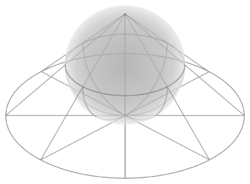Zero-dimensional space
From HandWiki
Short description: Topological space of dimension zero
| Geometry |
|---|
 |
| Geometers |
In mathematics, a zero-dimensional topological space (or nildimensional space) is a topological space that has dimension zero with respect to one of several inequivalent notions of assigning a dimension to a given topological space.[1] A graphical illustration of a nildimensional space is a point.[2]
Definition
Specifically:
- A topological space is zero-dimensional with respect to the Lebesgue covering dimension if every open cover of the space has a refinement which is a cover by disjoint open sets.
- A topological space is zero-dimensional with respect to the finite-to-finite covering dimension if every finite open cover of the space has a refinement that is a finite open cover such that any point in the space is contained in exactly one open set of this refinement.
- A topological space is zero-dimensional with respect to the small inductive dimension if it has a base consisting of clopen sets.
The three notions above agree for separable, metrisable spaces.[citation needed][clarification needed]
Properties of spaces with small inductive dimension zero
- A zero-dimensional Hausdorff space is necessarily totally disconnected, but the converse fails. However, a locally compact Hausdorff space is zero-dimensional if and only if it is totally disconnected. (See (Arhangel'skii Tkachenko) for the non-trivial direction.)
- Zero-dimensional Polish spaces are a particularly convenient setting for descriptive set theory. Examples of such spaces include the Cantor space and Baire space.
- Hausdorff zero-dimensional spaces are precisely the subspaces of topological powers where is given the discrete topology. Such a space is sometimes called a Cantor cube. If I is countably infinite, is the Cantor space.
Manifolds
All points of a zero-dimensional manifold are isolated.
Hypersphere
The zero-dimensional hypersphere (0-sphere) is a pair of points, and the zero-dimensional ball is a single point.[3]
Notes
- Arhangel'skii, Alexander; Tkachenko, Mikhail (2008). Topological Groups and Related Structures. Atlantis Studies in Mathematics. 1. Atlantis Press. ISBN 978-90-78677-06-2.
- Engelking, Ryszard (1977). General Topology. PWN, Warsaw.
- Willard, Stephen (2004). General Topology. Dover Publications. ISBN 0-486-43479-6.
References
- ↑ Hazewinkel, Michiel (1989). Encyclopaedia of Mathematics, Volume 3. Kluwer Academic Publishers. p. 190. ISBN 9789400959941. https://books.google.com/books?id=8aHsCAAAQBAJ&q=zero-dimensional+space+math&pg=PA190.
- ↑ Wolcott, Luke; McTernan, Elizabeth (2012). "Imagining Negative-Dimensional Space". in Bosch, Robert; McKenna, Douglas; Sarhangi, Reza. Phoenix, Arizona, USA: Tessellations Publishing. pp. 637–642. ISBN 978-1-938664-00-7. http://bridgesmathart.org/2012/cdrom/proceedings/65/paper_65.pdf. Retrieved 10 July 2015.
- ↑ Gibilisco, Stan (1983). Understanding Einstein's Theories of Relativity: Man's New Perspective on the Cosmos. TAB Books. p. 89. ISBN 9780486266596. https://books.google.com/books?id=fzZMuP2sF9sC&q=one-dimensional+space+Hypersphere&pg=PA98.
 |
